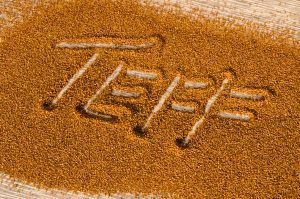Ancient Grains: Teff Veggie Stir Fry
Ancient Grains: Teff Veggie Stir Fry
The increased popularity of ancient grains has been driven by a growing awareness of their nutritional benefits and sustainability. Cultivated for thousands of years by civilizations around the world, they offer a wealth of health-promoting nutrients and unique flavors. Let’s learn a bit more about their history and value and then dive into your new favorite bowl or side dish, Teff Veggie Stir Fry.
Background
So what is an ancient grain? They are grains and pseudocereals (seeds that are consumed like grains) that have not been changed by human intervention. Common foods like corn, rice, and modern wheat are not ancient grains because they have been altered.
Dietary staples in many parts of the world, today these ancient grains offer tremendous value and promise to people everywhere. Their benefits include:
Nutritional Density
Ancient grains are valued for their exceptional nutritional density, offering higher levels of protein, fiber, vitamins, and minerals compared to modern grains.
Gluten Composition
While some ancient grains like kamut and spelt contain gluten, their gluten composition differs from modern wheat varieties. Many individuals with gluten sensitivities find that they can tolerate ancient grains better due to differences in gluten structure and digestion.
Sustainability
Ancient grains are also valued for their sustainability and resilience to environmental stressors. These heritage crops require fewer inputs such as water and fertilizers, and are naturally pest resistant when compared to modern monoculture crops, making them a more environmentally friendly choice.
Culinary Versatility
From savory dishes to baked goods, ancient grains offer unparalleled culinary versatility. Their unique flavors, textures, and nutritional profiles add depth and complexity to a wide range of recipes, inspiring creativity in the kitchen.
Most Popular
While many ancient grains and pseudocereals can be found in your local market today, perhaps the most popular are:
Quinoa. Originating from the Andean region of South America, quinoa has been a dietary staple for indigenous populations for centuries. Quinoa stands out for its high protein content, containing all nine essential amino acids, making it a complete protein source. Additionally, quinoa is rich in fiber, vitamins, and minerals, including iron, magnesium, and potassium.
Amaranth. Cultivated by the Aztecs in Central America and like quinoa, amaranth is a complete protein source and boasts high levels of fiber, calcium, and antioxidants. Its tiny grains can be cooked similarly to rice or ground into flour for baking.
Farro. Originally grown in ancient Mesopotamia (modern-day Iraq), farro is an ancient wheat variety known for its nutty flavor and chewy texture. Packed with fiber, protein, and essential nutrients such as magnesium and zinc, farro is used in salads, soups, and pilafs.
Teff. Native to Ethiopia and Eritrea, teff is the smallest grain in the world and has been a dietary staple in East African cuisines for millennia. Despite its small size, teff packs a nutritional punch, offering an excellent source of iron, calcium, and resistant starch. Teff flour is commonly used to make traditional Ethiopian flatbreads called injera.
Kamut. An ancient wheat variety originating from Egypt, compared to modern wheat, kamut contains higher levels of protein, essential fatty acids, and minerals like selenium and magnesium. Its large grains are ideal for pilafs, salads, and baked goods.
Excited to start adding ancient grains to your meals? Here’s an easy to make recipe to get you started.
Teff Veggie Stir-Fry
Yield: 4 Servings
Total Time: 40 minutes
Prep Time: 15 minutes
Cooking Time: 25 minutes
Ingredients
- 1 cup teff grains
- 2 cups water or vegetable broth
- 2 tablespoons olive oil
- 2 cloves garlic, minced
- 1 onion, thinly sliced
- 2 carrots, julienned
- 1 bell pepper, thinly sliced
- 1 cup broccoli florets
- 1 cup snow peas
- 1 tablespoon soy sauce, tamari, or liquid aminos
- 1 tablespoon rice vinegar
- 1 teaspoon sesame oil
- Salt and pepper to taste
- Optional: sliced green onions and sesame seeds for garnish
Directions
To prepare Teff for cooking, rinse the grains under cold water.
In a medium saucepan, bring 2 cups of water or vegetable broth to a boil. Add the rinsed teff grains, reduce heat to low, cover, and simmer for about 15-20 minutes, or until the teff is tender and the liquid is absorbed. Remove from heat and let it sit, covered, for 5 minutes. Fluff with a fork and set aside.
While the teff is cooking, heat 1 tablespoon of olive oil in a large skillet or wok over medium-high heat. First add the minced garlic and sliced onion, and sauté until fragrant and translucent, about 2-3 minutes.
Then add the remaining tablespoon of olive oil to the skillet. Lastly, add the julienned carrots, sliced bell pepper, broccoli florets, and snow peas. Stir-fry for 5-7 minutes, or until the vegetables are tender-crisp.
Add the cooked teff to the skillet with the vegetables. Drizzle with soy sauce, rice vinegar, and sesame oil. Season with salt and pepper to taste. Stir well to combine all the ingredients and evenly coat with the sauce.
Remove from heat and transfer the teff veggie stir-fry to serving plates. Garnish with sliced green onions and sesame seeds if desired. Enjoy!
Nutritional Information per Serving
Calories: 250; Total Fat: 8g; Saturated Fat: 1g; Trans Fat: 0g; Cholesterol: 0mg; Total Carbohydrates: 40g; Dietary Fiber: 7g; Sugars: 6g; Protein: 8g
- SHARE THIS POST



